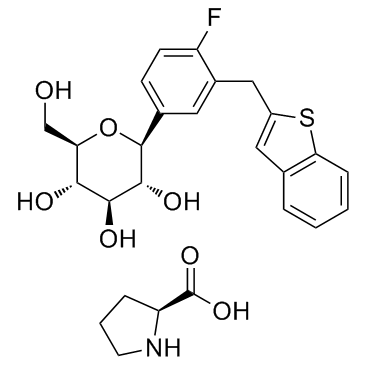Ipragliflozin L-Proline
Modify Date: 2024-01-02 10:51:14

Ipragliflozin L-Proline structure
|
Common Name | Ipragliflozin L-Proline | ||
|---|---|---|---|---|
| CAS Number | 951382-34-6 | Molecular Weight | 519.58200 | |
| Density | N/A | Boiling Point | N/A | |
| Molecular Formula | C26H30FNO7S | Melting Point | N/A | |
| MSDS | N/A | Flash Point | N/A | |
Use of Ipragliflozin L-ProlineIpragliflozin (L-Proline) is a highly potent and selective SGLT2 inhibitor with an IC50 of 2.8 nM; little and NO potency for SGLT1/3/4/5/6. |
| Name | (2S,3R,4R,5S,6R)-2-[3-(1-benzothiophen-2-ylmethyl)-4-fluorophenyl]-6-(hydroxymethyl)oxane-3,4,5-triol,(2S)-pyrrolidine-2-carboxylic acid |
|---|---|
| Synonym | More Synonyms |
| Description | Ipragliflozin (L-Proline) is a highly potent and selective SGLT2 inhibitor with an IC50 of 2.8 nM; little and NO potency for SGLT1/3/4/5/6. |
|---|---|
| Related Catalog | |
| Target |
IC50 value: 2.8 nM (SGLT2)[1][2]. |
| In Vitro | Ipragliflozin (L-Proline) potently and selectively inhibits human, rat, and mouse SGLT2 at nanomolar ranges and exhibits stability against intestinal glucosidases[3]. |
| In Vivo | Ipragliflozin (L-Proline) shows good pharmacokinetic properties following oral dosing, and dose-dependently increases urinary glucose excretion, which lasts for over 12 h in normal mice [3]. Oral administration of ipragliflozin increases urinary glucose excretion in a dose-dependent manner, an effect which is significant at doses of 0.3 mg/kg or higher and lasts over 12 h[4]. Single administration of ipragliflozin dose-dependently increases urinary glucose excretion, reduces blood glucose and plasma insulin levels, and improves glucose intolerance [5]. |
| References |
| Molecular Formula | C26H30FNO7S |
|---|---|
| Molecular Weight | 519.58200 |
| Exact Mass | 519.17300 |
| PSA | 167.72000 |
| LogP | 2.29790 |
| Storage condition | 2-8℃ |
| ASP-1941 |
| Ipragliflozin L-proline |
| UNII-M6N3GK48A4 |
| Ipragliflozin (L-Proline) |

